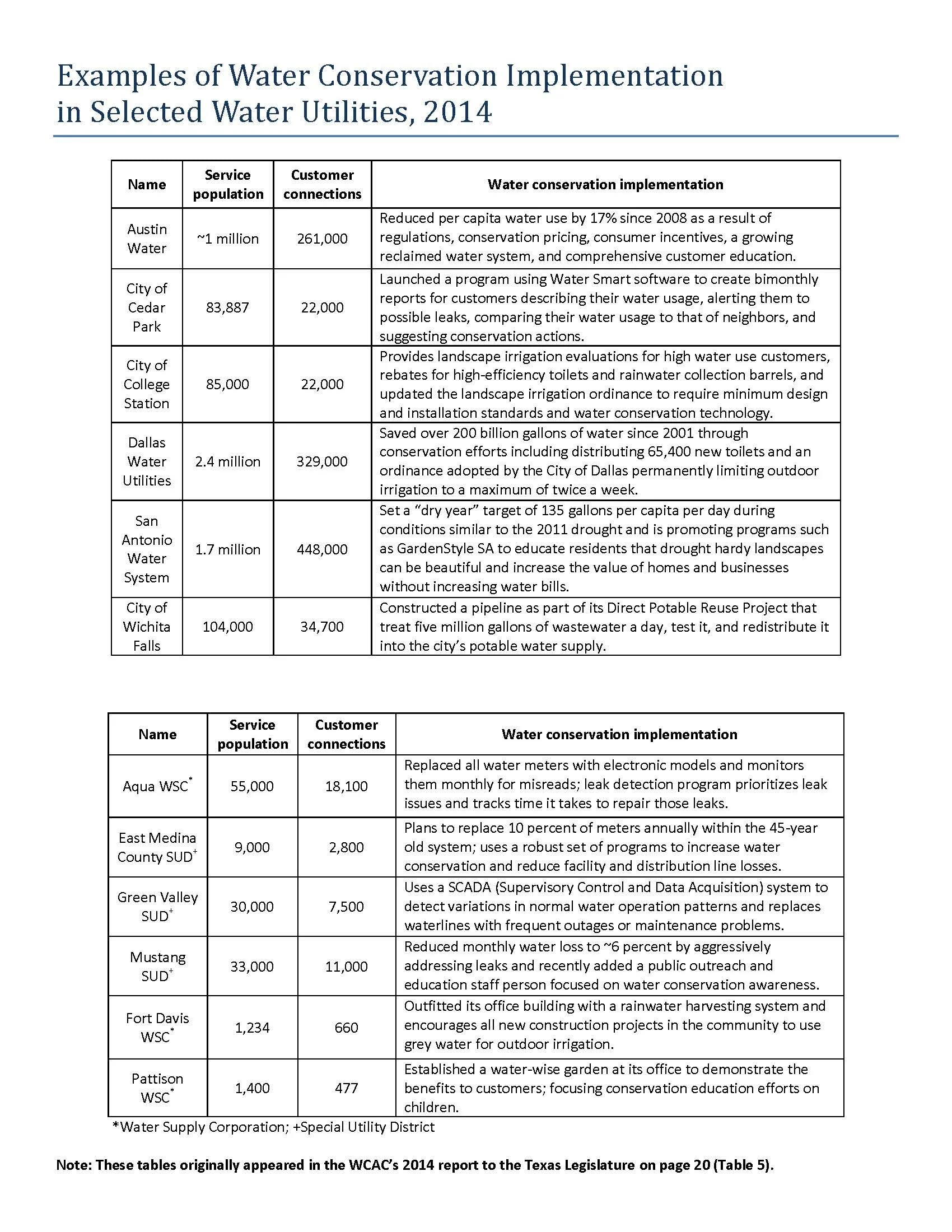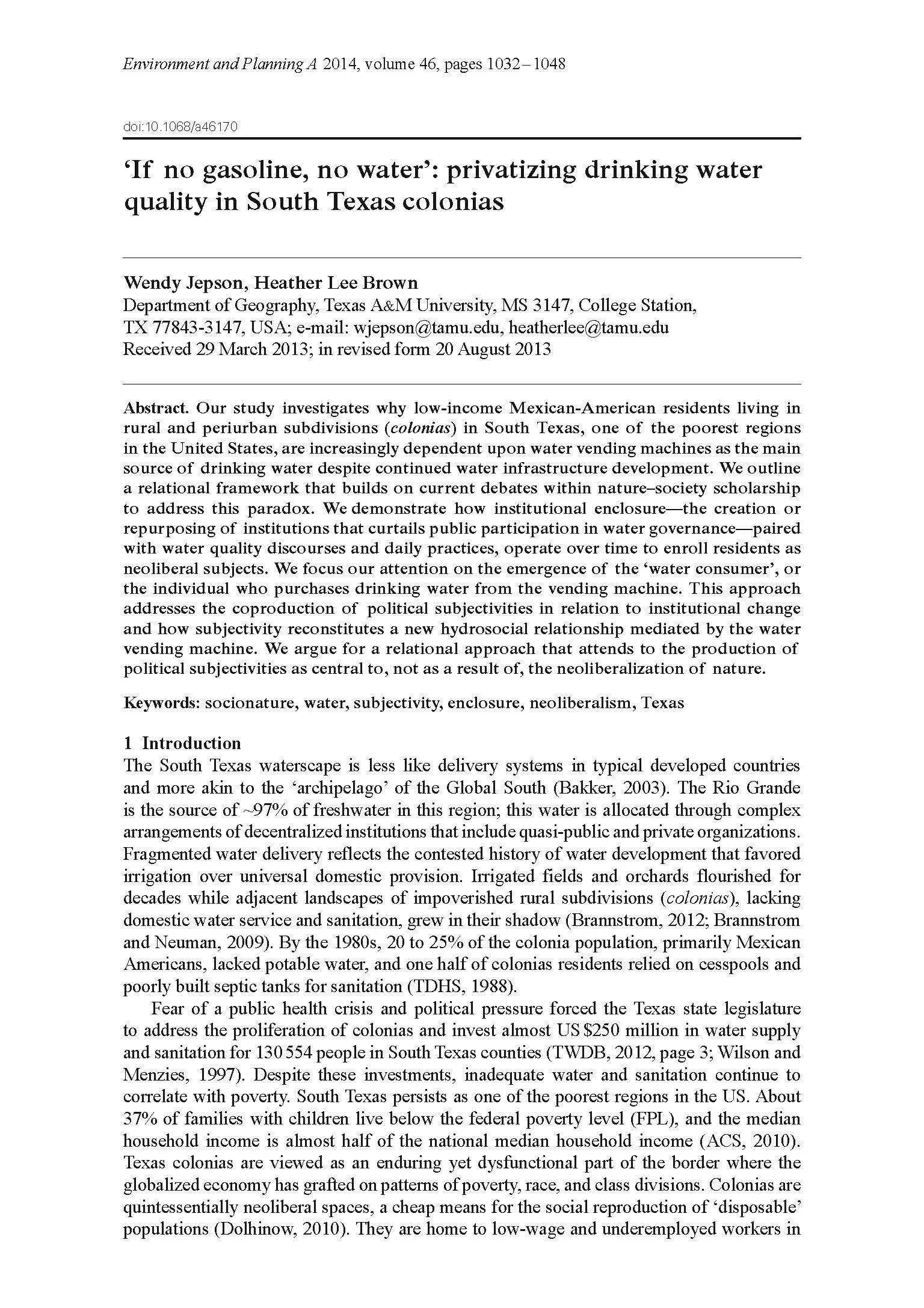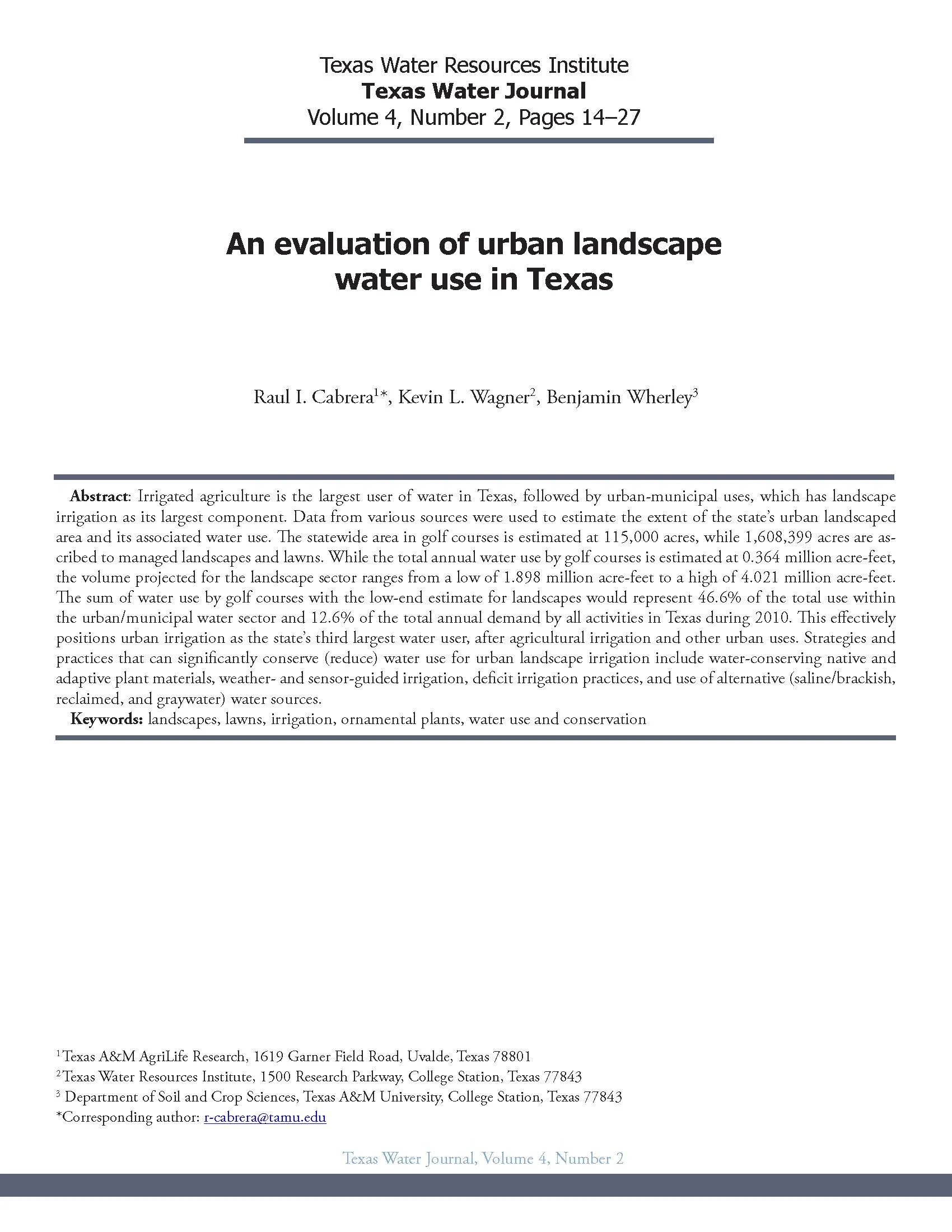This report analyzes implementation of water conservation strategies in Texas water planning regions C, H, and K.
Read MoreThe purpose of this analysis is to examine trends in water use and water use intensity for the manufacturing and electric power industry in Texas.
Read MoreThis report describes the results of a ten-year project to enable advances in the knowledge and practice of water saving technologies and management techniques in the agricultural sector.
Read MoreThis pamphlet describes agricultural water conservation in Texas and provides resources and maps.
Read MoreThis is a summary of the evaluations of 14 utilities’ required water conservation plans for compliance with the Texas Water Development Board’s best management practices when considering an application for financial assistance, submitted to the legislature in compliance with House Bill 3605.
Read MoreThe Texas Water Conservation Advisory Council's Report to the Legislature on the progress of water conservation in Texas.
Read MoreThis one-page water bill insert reminds water users that Texas continues to face drought conditions and asks them to pledge to use water wisely.
Read MoreThis brochure provides residential water users tips on efficient outdoor and indoor water use.
Read MoreThis report focuses on how a utility may use its water rates and financial policies to encourage customers to reduce their water use while maintaining the financial viability of the utility.
Read MoreThis one-pager provides examples of water conservation implementation in selected water utilities, including Austin Water, City of College Station, and Mustang SUD.
Read MoreOur study investigates why low-income Mexican-American residents living in rural and periurban subdivisions (colonias) in South Texas, one of the poorest regions in the United States, are increasingly dependent upon water vending machines as the main source of drinking water despite continued water infrastructure development. We outline a relational framework that builds on current debates within nature–society scholarship to address this paradox. We demonstrate how institutional enclosure—the creation or repurposing of institutions that curtails public participation in water governance—paired with water quality discourses and daily practices, operate over time to enroll residents as neoliberal subjects. We focus our attention on the emergence of the ‘water consumer’, or the individual who purchases drinking water from the vending machine. This approach addresses the coproduction of political subjectivities in relation to institutional change and how subjectivity reconstitutes a new hydrosocial relationship mediated by the water vending machine. We argue for a relational approach that attends to the production of political subjectivities as central to, not as a result of, the neoliberalization of nature.
Read MoreThis brochure describes ways that agricultural water users in Texas manage water use during drought.
Read MoreThis paper develops a household water security measurement for low-income peri-urban and rural communities (‘‘colonias’’) on the US–Mexico border. The complexity of a ‘‘no-win’’ waterscape – where water service exists but is relatively expensive and water quality is still precarious – precludes a meaningful assessment and analysis because there are no existing measurement tools to capture water insecurity at the household level. Informed by critical environmental epistemology, the paper incorporates perspectives from colonias residents through qualitative research and survey development. The study advances previous work on water security by developing a cumulative scale for each characteristic of household water security then clusters households into water security classes using a non-parametric statistical procedure. The analysis identified four water security classes: (1) Water Secure; (2) Marginally Water Secure; (3) Marginally Water Insecure; (4) Water Insecure. While all households in the survey are connected to water service, only 45% are broadly ‘‘water secure’’ while 55% are ‘‘water insecure.’’ Statistical analysis confirmed the robustness of the scaling and clustering procedure, thus, providing evidence to describe household water insecurity in ‘‘no-win’’ waterscapes.
Read MoreIncreasing interest and attention are being directed at the relationship between water and energy resources in the United States. To better weigh the trade-off s and take actions to optimize these resources in concert, the Alliance for Water Effi ciency (AWE) and the American Council for an Energy-Effi cient Economy (ACEEE) teamed up to investigate what relevant research and studies exist that can inform these actions. Even a modest inventory can inform choices about eff ective and relevant research investments as a fundamental method for addressing issues and challenges inherent to this relationship.This paper, prepared by GEI Consultants, Inc. on behalf of and in collaboration with AWE and ACEEE, provides the results of an assessment into the status of research on the relationship or “nexus” between the water and energy sectors. Publicly available research papers and studies that met certain criteria were collected and catalogued into a database. These included investigations that addressed the water sector’s impacts on energy resources and the energy sector’s impact on water resources, including development, operations, and end-uses. The compiled research was then assessed to determine the scope of topics investigated, the key results, and possible gaps. Finally, gaps in the research were identifi ed and inventoried. From this information, a roadmap for future research investments is recommended to enhance multi-sector resource management and overall resource effi ciencies. A summary of the major fi ndings from the collected research is provided and is compared to the major policy objectives and issues as identifi ed in the AWE-ACEEE publication, Addressing the Water-Energy Nexus: A Blueprint for Action and Policy Agenda (Blueprint). From this comparison, final recommendations were developed that address additional research needs.
Read MoreThis brief summarizes the need for and approaches to policy and educational programming on the importance of municipal, agricultural, and industrial water conservation.
Read MoreIrrigated agriculture is the largest user of water in Texas, followed by urban-municipal uses, which has landscape irrigation as its largest component. Data from various sources were used to estimate the extent of the state’s urban landscaped area and its associated water use. The statewide area in golf courses is estimated at 115,000 acres, while 1,608,399 acres are ascribed to managed landscapes and lawns. While the total annual water use by golf courses is estimated at 0.364 million acre-feet, the volume projected for the landscape sector ranges from a low of 1.898 million acre-feet to a high of 4.021 million acre-feet. The sum of water use by golf courses with the low-end estimate for landscapes would represent 46.6% of the total use within the urban/municipal water sector and 12.6% of the total annual demand by all activities in Texas during 2010. This effectively positions urban irrigation as the state’s third largest water user, after agricultural irrigation and other urban uses. Strategies and practices that can significantly conserve (reduce) water use for urban landscape irrigation include water-conserving native and adaptive plant materials, weather- and sensor-guided irrigation, deficit irrigation practices, and use of alternative (saline/brackish, reclaimed, and graywater) water sources.
Read More



















